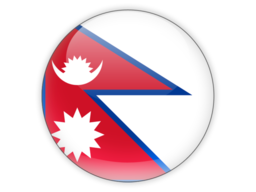







Nepal is a landlocked country in South Asia, bordered by China to the north and India to the south, east, and west. The country is known for its stunning Himalayan mountain range, including the world's tallest peak, Mount Everest. Nepal is a culturally rich country with diverse ethnic groups and religions.
Kathmandu, the capital city of Nepal, is a vibrant and bustling city, known for its temples, palaces, and vibrant culture. It is also the gateway to the Himalayas, with many trekking and mountaineering companies based in the city.
Nepal has a range of stunning landscapes, from the snowy peaks of the Himalayas to the lush tropical jungles of the Terai region. Popular tourist destinations include the cities of Pokhara and Bhaktapur, the Annapurna Circuit trek, Chitwan National Park, and the UNESCO World Heritage sites of Pashupatinath Temple, Boudhanath Stupa, and Swayambhunath Temple.
Nepal has a rich cultural heritage, with many traditional festivals celebrated throughout the year. The most famous festival is Dashain, which is celebrated in September or October and involves the worship of the goddess Durga. Other popular festivals include Tihar, Holi, and Teej.
Nepal is also famous for its cuisine, which is influenced by Indian and Tibetan flavors. Dal bhat is the national dish and consists of lentil soup, rice, and vegetables. Other popular dishes include momos (dumplings) and thukpa (noodle soup).
Nepal's economy is largely based on agriculture and tourism, with the majority of the population engaged in farming. The country has made significant progress in reducing poverty in recent years, although it remains one of the poorest countries in Asia.
Telephone Code
977
Local Emergency Phone
Ambulance: 228094; Fire: local number; Police: 100
Vaccinations
An International Certificate of Vaccination for yellow fever is required for travelers arriving from countries with a risk of yellow fever transmission and for travelers having transited through the airport of a country with risk of yellow fever transmission. See WHO recommendations.
Climate
Varies from cool summers and severe winters in north to subtropical summers and mild winters in south
Currency (Code)
Nepalese rupees (NPR)
Electricity/Voltage/Plug Type(s)
230 V / 50 Hz / plug types(s): C, D, M
Major Languages
Nepali, Maithali, Bhojpuri, Tharu, Tamang, Newar, Bajjika, Magar, Doteli, Urdu, Avadhi, Limbu, Gurung, Baitadeli; note: 123 languages reported as mother tongue
Major Religions
Hindu 81.3%, Buddhist 9%, Muslim 4.4%, Kirant 3.1%, Christian 1.4%
Potable Water
Opt for bottled water
International Driving Permit
An IDP is required, and after 15 days, a local license is required.
Road Driving Side
Left
Tourist Destinations
Kathmandu (includes Boudhanath Stupa, Durbar Square); Bhaktapur; Pokhara; Annapurna Circuit trek; Chitwan National Park; Lumbini (Buddha Birthplace)
Major Sports
Soccer, cricket, swimming, volleyball, tennis, martial arts
Cultural Practices
After food has touched ones lips, many Nepalese consider it unclean. This belief applies to drinking from bottled water, or offering to share snacks.
Tipping Guidelines
At restaurants, if a service charge has not been included, 10% of the bill is an acceptable tip. Porters may be tipped $2-4 (USD) per day, guides $3-5 (USD) per day.
Souvenirs
Knotted/woven carpets and hemp items, wool pashminas, sheepskin slippers, woven caps, kukri knives, precious metal and turquoise jewelry, sacred scroll paintings, wood instruments, lokta bark paper, tea, kitchen spices
Traditional Cuisine
Dal Bhaath/Bhat — rice served with lentil soup and vegetable or meat curry
Geography
Area
total: 147,181 sq km
land: 143,351 sq km
water: 3,830 sq km
Climate
varies from cool summers and severe winters in north to subtropical summers and mild winters in south
Natural resources
quartz, water, timber, hydropower, scenic beauty, small deposits of lignite, copper, cobalt, iron ore
People and Society
Population
30,899,443 (2023 est.)
Ethnic groups
Chhettri 16.6%, Brahman-Hill 12.2%, Magar 7.1%, Tharu 6.6%, Tamang 5.8%, Newar 5%, Kami 4.8%, Muslim 4.4%, Yadav 4%, Rai 2.3%, Gurung 2%, Damai/Dholii 1.8%, Thakuri 1.6%, Limbu 1.5%, Sarki 1.4%, Teli 1.4%, Chamar/Harijan/Ram 1.3%, Koiri/Kushwaha 1.2%, other 19% (2011 est.)
Languages
Nepali (official) 44.6%, Maithali 11.7%, Bhojpuri 6%, Tharu 5.8%, Tamang 5.1%, Newar 3.2%, Bajjika 3%, Magar 3%, Doteli 3%, Urdu 2.6%, Avadhi 1.9%, Limbu 1.3%, Gurung 1.2%, Baitadeli 1%, other 6.4%, unspecified 0.2%; note - 123 languages reported as mother tongue in 2011 national census; many in government and business also speak English (2011 est.)
Religions
Hindu 81.3%, Buddhist 9%, Muslim 4.4%, Kirant 3.1%, Christian 1.4%, other 0.5%, unspecified 0.2% (2011 est.)
Population growth rate
0.74% (2023 est.)
Government
Government type
federal parliamentary republic
Capital
name: Kathmandu
Economy
Economic overview
low-income South Asian economy; post-conflict fiscal federalism increasing stability; COVID-19 hurt trade and tourism; widening current account deficits; environmentally fragile economy from earthquakes; growing Chinese relations and investments
Real GDP (purchasing power parity)
$115.093 billion (2021 est.)
Real GDP per capita
$3,800 (2021 est.)
Agricultural products
rice, vegetables, sugar cane, potatoes, maize, wheat, buffalo milk, milk, fruit, mangoes/guavas
Industries
tourism, carpets, textiles; small rice, jute, sugar, and oilseed mills; cigarettes, cement and brick production
Exports
$2.52 billion (2021 est.)
Exports - partners
India 68%, United States 10% (2019)
Exports - commodities
palm oil, clothing and apparel, carpets, soybean oil, flavored water (2019)
Imports
$16.993 billion (2021 est.)
Imports - partners
India 70%, China 15% (2019)
Imports - commodities
refined petroleum, iron, broadcasting equipment, natural gas, rice (2019)




















